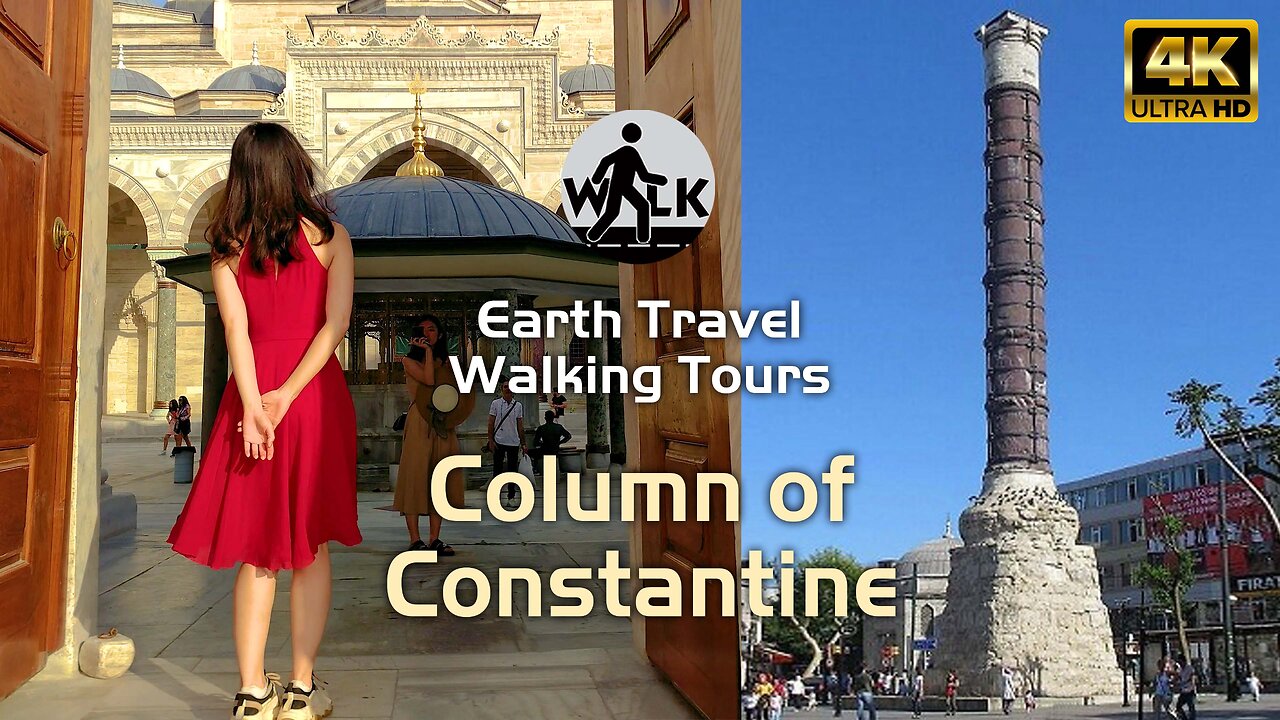Premium Only Content

Laleli to Column of Constantine Walking Tour - 4K UHD
Walk with me 👉 https://bit.ly/3O7D0vg
My walk map 👉 https://bit.ly/39d4hxW
The Column of Constantine (Turkish: Çemberlitaş Sütunu; Greek: Στήλη του Κωνσταντίνου Α΄; Latin: Columna Constantini) is a Roman monumental column built for Roman emperor Constantine the Great to commemorate the dedication of Constantinople on 11 May 330 AD. Built c. 328 AD, it is the oldest Constantinian monument in Istanbul and stood in the centre of the Forum of Constantine. It occupies the second-highest hill of the seven hills of Constantine's Nova Roma, the erstwhile Byzantium, and was midway along the Mese odos, the ancient city's main thoroughfare.
The column shaft itself is composed of very large porphyry column drums set on a white marble pedestal that is no longer visible. The column once supported a bronze statue of the emperor holding a spear and wearing a seven-point radiate crown, probably nude, and possibly holding an orb. Its appearance probably referred to the Colossus of Rhodes and to the Colossus of Nero in Rome; all resembled the solar deities Helios or Apollo. The statue and column capital fell down after some eight centuries, and were replaced with a cross, since removed, and the inscribed white marble masonry capital visible today.
The column's top is 34.8 m above the present-day ground level. Estimates of the original height of the column, without the statue, vary between 37 and 40 m; the monument as a whole would have been nearly 50 m tall. It may have been the largest Roman honorific column of all, rivalled only by the later Column of Theodosius in Constantinople, now demolished. Constantine's Column was taller than Trajan's Column and the Column of Marcus Aurelius in Rome; its size approached or exceeded the height of the Colosseum (48 m) and the internal height of the Pantheon (43 m) in Rome.
The Turkish name Çemberlitaş, from çemberli 'hooped' and taş 'stone', was applied after renovations by the Ottomans in c. 1515, who added iron reinforcing hoops to the shaft, and the name became a synecdoche for the local area: Çemberlitaş. Bronze reinforcements had first been added as early as 416. The monument sustained fire damage in the 5th and 6th centuries; in 1779, another fire blackened the column, which subsequently became known as the Burnt Pillar.
The column is where Yeniçeriler Caddesi ("Street of the Janissaries") adjoins the Divan Yolu ("Road to the Divan"); these streets connect Sultanahmet Square with Beyazıt Square and roughly follow the course of the old Mese odos. The Roman street led eastward to the Augustaion, the Hippodrome, Hagia Sophia, the Baths of Zeuxippus, and the Chalke Gate of the Great Palace. To the west the way led through the Forum of Theodosius to the Philadelphion and the walls of Constantinople. In Constantine's Forum itself the emperor built the original home of the Byzantine Senate.
History
The column was dedicated on May 11, 330 AD, with a mix of Christian and pagan ceremonies.
In Constantine's day the column was at the center of the Forum of Constantine (today known as Çemberlitaş Square), an oval forum situated outside the city walls in the vicinity of what may have been the west gate of Antoninia. On its erection, the column was 50 meters tall, constructed of several cylindrical porphyry blocks. The exact number of porphyry blocks is disputed, but common figures range from seven, up to as many as eleven.[3] These blocks were surmounted by a statue of Constantine in the figure of Apollo. The orb he carried was said to contain a fragment of the True Cross. At the foot of the column was a sanctuary which contained relics allegedly from the crosses of the two thieves who were crucified with Jesus Christ at Calvary, the baskets from the loaves and fishes miracle, an alabaster ointment jar belonging to Mary Magdalene and used by her for anointing the head and feet of Jesus,[4] and the palladium of ancient Rome (a wooden statue of Pallas Athena from Troy).
A strong gale in 1106 AD felled the statue and three of the upper cylinders of the column. Some years later, Byzantine emperor Manuel I Komnenos (reigned 1143–1180) placed a cross on top in place of the original statue and added a commemorative inscription that read "Faithful Manuel invigorated this holy work of art, which has been damaged by time". Bronze wreaths once covered the joints between the drums, but these were taken by the Latin Crusaders who plundered the city during the Fourth Crusade in 1204. The cross was removed by the Ottoman Turks after the fall of Constantinople in 1453.
Social Media / Contact
Twitter : https://twitter.com/travelwalking
Instagram : https://www.instagram.com/earthtravelwalkingtours
Facebook : https://www.facebook.com/Earth-Travel-Walking-Tours-102888222457618
Web : http://www.earthtravelwalkingtours.com
E-mail : earthtravelwalkingtours@gmail.com
-
 LIVE
LIVE
TheAlecLaceShow
2 hours agoDan Bongino Joins Kash Patel at FBI | Vivek For Ohio | Where’s the Epstein List | The Alec Lace Show
142 watching -
 55:46
55:46
The Dan Bongino Show
4 hours agoChange Is Coming, And All The Right People Are Panicking (Ep. 2430) - 02/25/2025
666K1.7K -
 1:11:08
1:11:08
The Rubin Report
2 hours agoTimothée Chalamet Stuns Crowd with Speech Pushing This Conservative Value
40.2K29 -
 1:40:31
1:40:31
Benny Johnson
2 hours ago🚨Deep State DESTROYING Evidence!? FBI Caught DELETING Files, Epstein List COVERUP | Investigate NOW
58K87 -
 2:00:34
2:00:34
Steven Crowder
4 hours ago🔴 False Reality: What Joy Reid's Firing Exposes About The Left
341K281 -
 1:34:39
1:34:39
Tucker Carlson
1 day agoLuke Gromen: Why the CIA Doesn’t Want You Owning Gold, & Is Fort Knox Lying About Our Gold Reserve?
148K194 -
 1:03:56
1:03:56
Timcast
3 hours agoRachel Maddow SLAMS MSNBC As RACIST For Firing Joy Reid, Liberal Media HAS COLLAPSED | Timcast LIVE
77.6K62 -
 DVR
DVR
Bannons War Room
7 days agoWarRoom Live
1.77M341 -
 56:45
56:45
VSiNLive
3 hours ago $1.80 earnedA Numbers Game with Gill Alexander | Hour 1
50.5K2 -
 2:03:41
2:03:41
Matt Kohrs
11 hours agoMore Market Pain Incoming?! || The MK Show
128K2